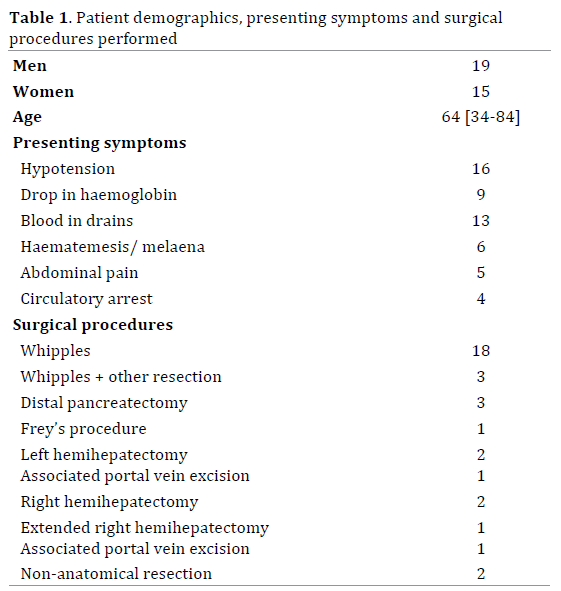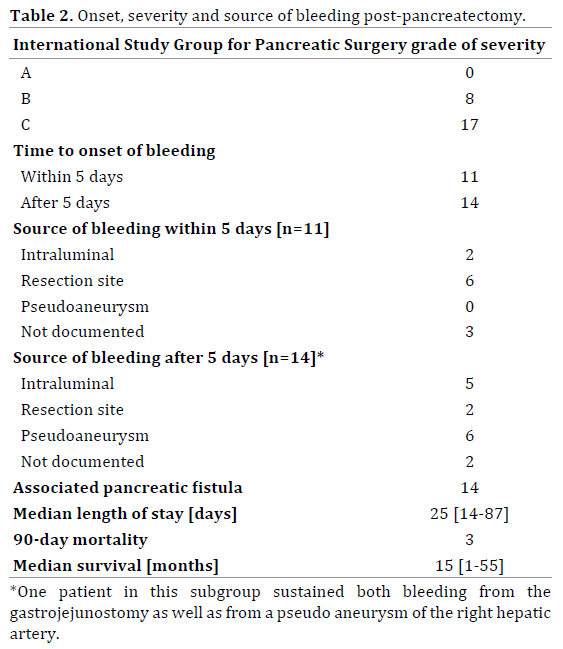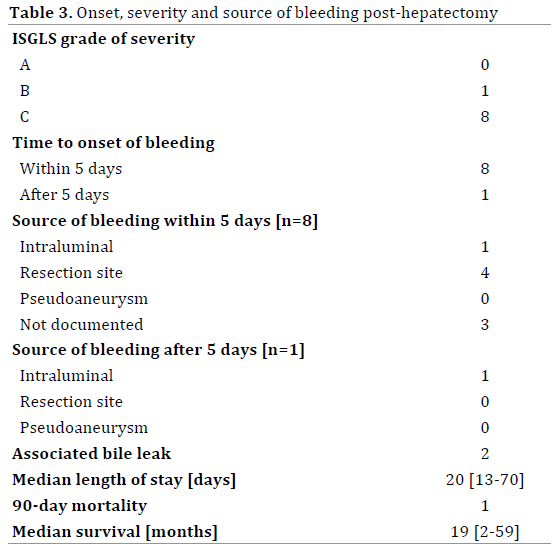- (2015) Volume 16, Issue 3
Anita Balakrishnan, Sirke Rinkoff, Petra Goldsmith, Simon J F Harper, Neville V Jamieson, Emmanuel L Huguet, Asif Jah and Raaj K Praseedom
Department of Hepatopancreaticobiliary Surgery, Addenbrooke’s Hospital, Hills Road, Cambridge, United Kingdom
Received March 02nd, 2015 – Accepted April 07th, 2015
Context Post-operative haemorrhage is a known complication of hepatopancreatobiliary surgery. Prompt treatment minimizes mortality and morbidity, however, there is currently little uniformity in the management of this complication. Objective The total numbers of pancreatectomies or liver resections were identified using hospital episode statistic data. Methods Patients who experienced post-operative bleeding were identified with keyword searches of all discharge letters, imaging reports and the theatre-coding database for the period between January 2005 and December 2011. Treatment modalities for control of haemorrhage as well as morbidity, mortality, length of stay and survival were examined. Results Thirty-four of the 768 pancreatic and liver resections performed experienced post-operative haemorrhage. More patients bled following pancreatectomies [6.1%] compared to hepatectomies [2.5%]. Bleeding was controlled using endoscopic, interventional radiological or surgical methods; re-laparotomy provided definitive management in the majority of patients. Post-pancreatectomy haemorrhage was associated with significantly increased mortality [P=0.004]. Length of stay was increased following haemorrhage post-pancreatectomy or hepatectomy [P<0.05]. Conclusions Our study highlights the substantial increase in mortality and length of stay following post-pancreatectomy and post-hepatectomy haemorrhage. Re-laparotomy was frequently required for control of bleeding. Our proposed management algorithm based on the timing and site of bleeding may standardize treatment in this heterogeneous group.
Aneurysm, False; Haemorrhage; Hepatectomy; Pancreaticoduodenectomy Non-standard abbreviations PPH post-pancreatectomy haemorrhage; PHH post-hepatectomy haemorrhage ISGPS International Study Group of Pancreatic Surgery; ISGLS International Study Group of Liver Surgery
There has been a marked increase in pancreatic and liver resections carried out over the past couple of decades, likely related to broadened criteria for resectability and increased detection of disease [1-3]. This has been accompanied by a decrease in mortality rates [4-8], however the morbidity associated with these procedures has remained high [2, 6, 9-11].
Post-operative haemorrhage is an infrequent but serious complication of hepatopancreaticobiliary surgery which accounts for between 11-38% of overall post-operative mortality [6, 10-14]. Management is dictated by the source and timing of bleeding; early detection and prompt treatment is of utmost necessity to minimize mortality [15, 16]. Options for control of the haemorrhage range from relaparotomy to less invasive means such as endoscopy or interventional radiology. Currently, there is little uniformity in terms of the management of this complication across the various surgical centers. The treatment option chosen in each case is ultimately guided by institutional experience and occasionally limited by facilities available. This study reviews our experience of the diagnosis and management of haemorrhage following liver and pancreatic resections and proposes an algorithm to standardize management in this heterogeneous group.
Total numbers of patients who underwent pancreatectomies or liver resections in our tertiary referral center between January 2005 and December 2011 were identified from hospital episode statistics data.
Patients who bled post-operatively during this period were identified by keyword searches of discharge letters, imaging reports and the theatre coding database for the words “haemorrhage”, “bleeding”, “contrast extravasation”, “pseudoaneurysm” and “haematoma”. Electronic medical records (containing endoscopy reports and clinic letters) and medical notes of these patients were reviewed.
Patients were suspected to have bled post-operatively if they sustained abdominal pain, bruising, hypotension or a drop in haemoglobin. Computed tomography (CT) scanning with non-contrast, arterial and portal phases was performed followed by angiography and embolization, endoscopy or re-laparotomy as necessary.
Inclusion criteria were modified from the definition of postpancreatectomy haemorrhage (PPH) or post-hepatectomy haemorrhage (PHH) established by the international study group of pancreatic surgery (ISGPS) or liver surgery (ISGLS) respectively [17, 18]. Patients were included if there was either a drop in haemoglobin of more then 3 g/dL compared to baseline post-operative haemoglobin levels, the requirement for a post-operative blood transfusion or for therapeutic endoscopy, interventional radiology or re-laparotomy. Patients who underwent only palliative bypasses or pancreatic debridement were excluded.
Thirty-day mortality was calculated as a standard endpoint. 90-day mortality was also calculated to ensure that patients who might have died outside hospital or upon readmission were included. Median survival was calculated as survival from the date of surgery to the date of death or censorship. Statistically significant differences between groups were identified using Fisher’s exact test or the non-parametric Mann-Whitney U test.
Incidence of Bleeding and Demographic Data
Seven-hundred-and-sixty-eight pancreatectomies and hepatectomies were performed between January 2005 and December 2011. Thirty-four patients bled, with a cumulative incidence of bleeding of 4.4% across all procedures. Nineteen were male and 15 were female, with a median age of 64 (range 34-84 years, Table 1).

Presenting Symptoms of Bleeding and Time to Onset of Bleeding
The commonest presenting symptoms were hypotension (n=16), drop in haemoglobin (n=9), blood in drains (n=13), haematemesis or melaena (n=6) and abdominal pain (n=5, Table 1). Some 4 patients had circulatory arrest; 3 required urgent laparotomy, and one died before laparotomy could be performed. Some patients had more than one symptom.
Mortality and Length of Stay
The 90-day mortality rate for patients who bled was 11.7% (4 of 34) compared to 0.68% (5 of 734; P=0.0003). In total, 4 of the 34 patients died within 90 days of surgery (11.7%) compared to 5 of the 733 patients who did not bleed (0.68%, P=0.0003). The overall 90-day mortality of the entire series was 1.17% (9 of 768). The median length of stay of the patients who bled and survived 90 days was 24 days (range 8-87 days).
Bleeding Post-pancreatectomy
Some 408 patients underwent pancreatectomies over this 7-year period. Twenty-five (25) patients bled (6.1%). Primary surgical procedures performed were Whipple’s resections (n=21), distal pancreatectomies (n=3) or Frey’s procedure (n=1, Table 1). Three of the 25 patients required more extensive resections in addition to a Whipple’s including a non-anatomical liver resection (n=1), right hemicolectomy (n=1) and en bloc right nephrectomy and right hemicolectomy (n=1). One patient required a distal pancreatectomy with en bloc resection of the left adrenal and partial gastrectomy. One of the distal pancreatectomies was performed laparoscopically, all the other pancreatectomies were performed as open procedures. The final histological diagnoses in the resected pancreatic specimens included pancreatic ductal adenocarcinoma (n=13), neuroendocrine tumours (n=3), cystic lesions (n=3), chronic calcific pancreatitis (n=1), distal cholangiocarcinoma (n=3) and metastatic renal cell cancer (n=2). All of these patients met grade B (n=8) or C (n=17) of the definition of PPH of the ISGPS (Table 2)[17]. Triple-phase CT imaging was performed in all patients except six (24% of those who bled) who experienced sudden onset bleeding with haemodynamic instability requiring urgent laparotomy.

Eleven of the 25 patients bled within 5 days of surgery (Figure 1, Table 2). Nine of these 11 patients required a laparotomy for control of the bleeding. One of these patients bled on the 1st day post-pancreaticoduodenectomy from the duodenal mesentery. Although this was controlled at laparotomy, the patient unfortunately collapsed and died on the ward on the 8th post-operative day. Postmortem examination revealed blood in the peritoneal cavity suggesting haemorrhage as the cause of death. Other sites of early PPH noted on re-laparotomy were splenic vein tributaries, perinephric fat, gallbladder fossa, duodenal or jejunal mesentery and peripancreatic tissue. Two (2) patients bled from the gastrojejunostomy in the early post-operative period which could not be managed endoscopically requiring refashioning of the anastomosis.
Some 14 patients bled after the 5th post-operative day (range 6-61 days, Figure 1, Table 2); commonest causes were anastomotic bleeding and pseudoaneurysms. Anastomotic bleeding occurred from the gastrojejunostomy (n=3), pancreaticojejunostomy (n=1) or hepaticojejunostomy (n=1). Endoscopic treatment of gastrojejunostomy bleeding via oesophagogastroduodenoscopy (OGD) was unsuccessful in all 3 patients. All 5 patients with anastomotic bleeding therefore required re-laparotomy and revision of the anastomosis.
Six patients bled from pseudoaneurysms arising from branches of the right hepatic, common hepatic or splenic arteries. The bleeding was successfully treated by radiologic embolization in 2 of these patients however unfortunately one patient subsequently died of a massive pulmonary embolus. The remaining 4 patients could not be embolized successfully and required laparotomy for control of the bleeding. One of these six patients bled from a pseudoaneurysm of the hepatic artery 21 days post-operatively. Despite stenting, the pseudoaneurysm recanalised and bled 39 days later causing circulatory arrest, acidosis and anaemia. Bleeding was controlled at laparotomy however the patient remained coagulopathic, developed multiorgan failure and died in intensive care later that day. The sources of bleeding in 3 further patients were erosion of the posterior wall of the stomach in the presence of a pancreatic leak, a perisplenic haematoma requiring a subsequent splenectomy and a haematoma posterior to the stomach, which was successfully drained via endoscopic ultrasound.
Pancreatic leaks occurred in 14 of the 25 pancreatectomies that bled post-operatively (51.9%). The incidence of pancreatic leaks was significantly higher in PPH after day 5 (12 leaks in 14 patients) compared to those that bled within 5 days of the original operation (2 leaks in 11 patients, P=0.0012). All six patients with pseudoaneurysms had associated pancreatic leaks.
There were three 90-day mortalities in this subgroup of 25 patients (12%, Table 2). This compares to a total of six 90- day mortalities across all 408 pancreatic resections over this time period (1.5%) and 3 deaths in the subgroup of 383 patients that did not bleed (0.8%); suggesting that PPH had a significantly increased mortality rate compared to those who did not experience this complication (P=0.004). 30-day mortality was also significantly higher following PPH (2 of 25 patients, 8.0%) compared to patients who did not bleed (3 of 383 patients, 0.8%, P=0.032).
The median length of stay following PPH was 25 days (range 14-87 days). In contrast the median length of stay of patients who had not bled following pancreatectomies during this time period was significantly lower at 17 days (range 6-133 days, P=0.0003). The median survival (to death or date of censorship) of the patients who bled was 15 months (range 1 to 55 months).
Bleeding Post-hepatectomy
360 hepatectomies were performed over this 7-year period. Nine of these patients experienced PHH (2.5%). The resections performed in this group of patients were extended right hemihepatectomies (n=2), left hemihepatectomies (n=3, including one biliary reconstruction), right hemihepatectomies (n=2) and nonanatomical liver resections (n=2). All the hepatectomies performed were open procedures. The final diagnoses in the resected specimens included colorectal liver metastases (n=3), hepatocellular carcinoma (n=4), hilar cholangiocarcinoma (n=1) and gallbladder carcinoma (n=1). Eight of the nine patients met grade C of the ISGLS criteria for severity while the remaining case was of grade B severity [18](Table 3).

Re-laparotomy was required for control of PHH in 7 patients (Figure 2). The causes of bleeding in 5 of these 7 patients were bleeding from the resection margin (n=2), portal vein (n=1), perinephric fat (n=1) and refashioning of a bleeding anastomosis following biliary reconstruction (n=1). The cause of bleeding was unclear for 2 of these 7 patients.
Two patients did not have surgical intervention for the bleeding. One patient bled from gastric varices secondary to splenic vein occlusion; this was successfully managed endoscopically. One patient had rapid circulatory arrest and died following evidence of blood in the drains. Postmortem examination suggested haemorrhage from the hepatic resection margin as the likely cause of death.
There were no pseudoaneurysms in this group of patients and a bile leak was only a coexisting factor in two patients in whom the source of bleeding was identified as the portal vein and the right perinephric fat.
There was one 90-day mortality in 9 patients with PHH (11.1%, Table 3). Although this was a higher percentage than in those patients that did not bleed (2 of 350, 0.6%) the small incidence meant that this difference did not meet statistical significance (P=0.07). All deaths occurred in hospital. Only one of the three deaths in the non-bleeding subgroup occurred within 30-days hence bleeding was associated with a significantly higher 30-day mortality rate (0.3% vs 11.1%, P=0.049).
The median length of stay following PHH was 20 days (range 13-70 days, Table 3). This was significantly longer than the median length of stay of 10 days in those patients who did not bleed (range 3-152, P=0.0015). The median survival of these patients is 19 months (range 2 to 59 months).
In this study we examined the incidence and outcomes of bleeding following PPH and PHH in our unit. Our data show a 4.4% incidence of PPH and PHH which compares favourably with the 1% to 16% reported in the published literature [8, 12, 13, 15, 19-23]. Post-operative bleeding had serious consequences in terms of increased length of stay, the need for further, often operative, intervention and mortality.
The incidence of PPH was 6.1%, similar to the published rate of 3-16%[15, 19-22]. PPH was associated with a 90- day mortality rate of 12%, which although significantly higher than the mortality rate of patients who did not bleed, is lower than the mortality rate of 16%-47% associated with PPH in the literature[15, 19-22].
Analysis of our experience with post-operative haemorrhage has led us to develop an algorithm for the suggested management of bleeding based on the timing of the onset of bleeding. Early post-operative bleeding usually occurs either from the site of dissection or intraluminally from one of the enteric anastomoses. Management of bleeding in this group therefore requires early re-laparotomy or urgent endoscopy respectively; this is illustrated by the algorithm in Figure 3.
Pseudoaneurysms are a known and dreaded cause of PPH and have been documented as the source of bleeding in up to 66% of patients with delayed PPH [22]. This late complication was the source of bleeding in 6 of our patients who bled after 5 days post-pancreatectomy. No PPH within 5 days of pancreatectomy was associated with a pseudoaneurysm on imaging. Sentinel bleeds occur in up to 50% of bleeding pseudoaneurysms [22]. Early CT angiography and subsequent treatment were initiated as soon as bleeding was suspected, hence in the absence of a subsequent larger bleed the classical “sentinel” bleed [a small herald bleed preceding a larger bleed] [24] could not be said to have taken place in our patients. Pancreatic leaks are the commonest risk factor for the development of pseudoaneurysms post-pancreatectomy [9, 25, 26]; all 6 patients with pseudoaneurysms in our study had associated pancreatic leaks. Radiological embolization or stenting is considered the least invasive management option and is associated with reduced mortality compared to surgery, however in some centers laparotomy has remained the treatment of choice for delayed PPH [15, 16, 22]. The high mortality associated with surgical management in these patients is related to difficulty in accessing the bleeding point, friability of tissues as well as the physiological toll of a further laparotomy on an acutely unwell patient [26, 27]. Selective embolization was attempted in all 6 pseudoaneurysms in our study, however was only successful in 2 patients. In the absence of a relevant randomized trial, a recent systematic review has suggested a slightly higher rate of success with laparotomy despite success rates of up to 80% with interventional radiology [22]. Moreover, the outcome of endovascular stenting in the presence of a leak or sepsis is not well understood.
Laparotomy provided definitive control of bleeding in the majority of patients and was employed upon failure of radiological embolization or stenting of pseudoaneurysms, failure of therapeutic endoscopy to control bleeding from the gastrojejunostomy and to manage bleeding where a specific site had not been localised on CT or angiography. Our experience and the evidence from the literature cumulatively suggest radiological management of delayed PPH in the first instance where feasible, particularly for pseudoaneurysms, with surgical management reserved as an option for those that cannot be controlled by radiological means. This suggested management algorithm is presented in Figure 4.
Fewer patients experienced haemorrhage as a complication of hepatectomy. The 2.5% rate of PHH is within the range of 1-8% reported in the literature [8, 12, 13, 23]. Unlike the instances of PPH, 8 out of 9 post-hepatectomy bleeds occurred within 5 days of resection. In the majority of these patients bleeding was from the cut surface of the liver, consequently 7 of these 9 patients were managed by re-laparotomy.
Although there were no pseudoaneurysms in this patient group, pseudoaneurysms are a well-recognised source of PHH particularly in the context of a bile leak. The management of these patients is similar to those who develop pseudoaneurysms post-pancreatectomy and should be managed as illustrated in the algorithm in Figure 4. Although the small incidence precludes meaningful calculations of statistical significance in these patients, the relatively high rate of mortality in following PHH compared to those who did not bleed is an indication of the potential severity of this complication and corresponds with the significant increase in median length of stay associated with PHH.
Our findings confirm that post-operative haemorrhage remains one of the most serious complications following major hepatopancreaticobiliary surgery and is associated with increased mortality. We show that rates of bleeding post-resection in our unit are comparable to that in the literature with lower in-hospital and 30-day mortality rates, and in addition present algorithms for the management of early and late PPH and PHH.
The authors had no conflicts of interest